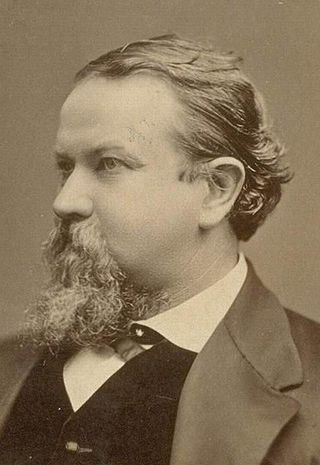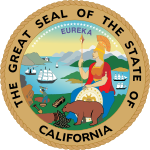
The Seventeenth Amendment to the United States Constitution established the direct election of United States senators in each state. The amendment supersedes Article I, Section 3, Clauses 1 and 2 of the Constitution, under which senators were elected by state legislatures. It also alters the procedure for filling vacancies in the Senate, allowing for state legislatures to permit their governors to make temporary appointments until a special election can be held.

The California State Legislature is the bicameral state legislature of the U.S. state of California, consisting of the California State Assembly and the California State Senate. Both houses of the Legislature convene at the California State Capitol in Sacramento.

The California State Senate is the upper house of the California State Legislature, the lower house being the California State Assembly. The state senate convenes, along with the state assembly, at the California State Capitol in Sacramento.

José Antonio Romualdo Pacheco was a Californio statesman and diplomat. A Republican, he is best known as the only Hispanic man to serve as governor of California since the American Conquest of California, and as the first Latino to represent a state in the U.S. Congress. Pacheco was elected and appointed to various state, federal, and diplomatic offices throughout his more than thirty-year career, including serving as a California State Treasurer, California State Senator, and three terms in the U.S. House of Representatives.

Milton Slocum Latham was an American politician, who served as the sixth governor of California and as a U.S. Representative and U.S. Senator. Latham holds the distinction of having the shortest governorship in California history, lasting for five days between January 9 and January 14, 1860. A Lecompton Democrat, Latham resigned from office after being elected by the state legislature to a seat in the U.S. Senate.

John Laird is an American politician who is the California State Senator for District 17, since December 7, 2020, and was Secretary of the California Natural Resources Agency from 2011 to 2019 and a former legislator who represented the 27th district in the California State Assembly until 2008. The 27th district included parts of Santa Clara County, Santa Cruz County and Monterey County.

John Percival Jones was an American politician who served for 30 years as a Republican United States Senator from Nevada. He made a fortune in silver mining and was a co-founder of the town of Santa Monica, California.
Districts in California geographically divide the U.S. state into overlapping regions for political and administrative purposes.

The 1876–77 United States Senate elections were held on various dates in various states, coinciding with Rutherford B. Hayes's narrow election as president. As these U.S. Senate elections were prior to the ratification of the Seventeenth Amendment in 1913, senators were chosen by state legislatures. Senators were elected over a wide range of time throughout 1876 and 1877, and a seat may have been filled months late or remained vacant due to legislative deadlock. In these elections, terms were up for the senators in Class 2.

The 1878–79 United States Senate elections were held on various dates in various states. As these U.S. Senate elections were prior to the ratification of the Seventeenth Amendment in 1913, senators were chosen by state legislatures. Senators were elected over a wide range of time throughout 1878 and 1879, and a seat may have been filled months late or remained vacant due to legislative deadlock. In these elections, terms were up for the senators in Class 3.

The 1884–85 United States Senate elections were held on various dates in various states, coinciding with the presidential election of 1884. As these U.S. Senate elections were prior to the ratification of the Seventeenth Amendment in 1913, senators were chosen by state legislatures. Senators were elected over a wide range of time throughout 1884 and 1885, and a seat may have been filled months late or remained vacant due to legislative deadlock. In these elections, terms were up for the senators in Class 3.

The 1890–91 United States Senate elections were held on various dates in various states. As these U.S. Senate elections were prior to the ratification of the Seventeenth Amendment in 1913, senators were chosen by state legislatures. Senators were elected over a wide range of time throughout 1890 and 1891, and a seat may have been filled months late or remained vacant due to legislative deadlock. In these elections, terms were up for the senators in Class 3.

The California state elections, November 2010 were held on November 2, 2010.

The 2014 United States elections were held on Tuesday, November 4, 2014, in the middle of Democratic President Barack Obama's second term. A typical six-year itch midterm election suffered by most second-term presidents, this election saw the Republican Party retaining control of the House of Representatives and winning control of the Senate, while furthering their gains in the governorships and state legislatures. Because of these Republican gains, the election was commonly cited as a "red wave" election.

Warren Chase was an American pioneer, farmer, reformer and politician. He served in the state senates of Wisconsin and California, and was a candidate for Governor of Wisconsin in the election of 1849.
Often referred to as the Rogers Free Library Act, the Rogers Act of 1878 was an 1877 bill written in the upper house of the California State Legislature and signed into law on March 18, 1878, by Governor of California William Irwin. It was entitled "An Act to establish and maintain free public libraries and reading rooms" and popularly named after its lead author, State Senator George H. Rogers.
The 1900 United States Senate special election in California was held on February 6, 1900, by the California State Legislature to elect a U.S. Senator to represent the State of California in the United States Senate. Legislators had previously attempted to elect a Senator in 1899, but could not reach a majority for a single candidate. Republican oil executive Thomas R. Bard was elected over Democratic San Francisco Mayor James D. Phelan.

Two United States Senate elections were held in Illinois on March 26, 1913. The two elections were interconnected through a compromise made to elect a Democrat in the regular election and a Republican in the special election.

The 2020 California State Senate election was held on Tuesday, November 3, 2020, with the primary election scheduled for March 3, 2020. Voters in the 20 odd-numbered districts of the California State Senate elected their representatives. The elections coincided with the elections for other offices, including for U.S. President and the state assembly.

















